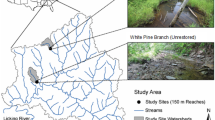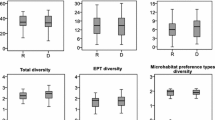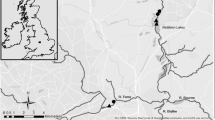Abstract
Stream restoration is meant to mitigate increasing anthropogenic pressure and re-establish ecosystem functioning and biodiversity. Extensive research has identified constraints hampering biotic recovery, but successful projects are still scarce. This study documents short-term macroinvertebrate colonisation in a near-natural environment with plentiful potential colonists, which has rarely been studied. Three streams contiguous with near-natural aquatic habitats were monitored over sixteen months after restoration. Sampling sections were categorised and compared to reference sections. Species richness and composition, abundance, functional parameters and similarity to reference were evaluated. Restored streams were colonised rapidly and, in multiple respects, reached reference levels within the study period. Distance from upstream colonisation source and restoration method (newly built and rebuilt channels) had little effect on recovery. However, species composition of upper and lower sections diversified, as they receive colonists from various sources. Repeated sampling revealed dynamic assemblage development with Chironomidae, Baetidae and Nemouridae being among the pioneer colonists. A common successional pattern was observed; gatherers/collectors and small, plurivoltine larvae decreased, whereas predators, grazers/scrapers and medium-sized, univoltine larvae increased. This study demonstrates that restoration of previously channelised streams in near-natural environment is followed by rapid macroinvertebrate colonisation, successfully promoting biodiversity.





Similar content being viewed by others
Data availability
Raw data that support the findings of this study are not public but may be acquired from the corresponding author upon reasonable request.
References
Al-Zankana, A. F. A., T. Matheson & D. M. Harper, 2020. How strong is the evidence - based on macroinvertebrate community responses - that river restoration works? Ecohydrology & Hydrobiology 20: 196–214.
Andersen, T., P. S. Cranston & J. H. Epler, 2013. The larvae of chironomidae (diptera) of the holarctic region: keys and diagnoses. Insect Systematics & Evolution, Suppl. 66, Lund.
Arango, C. P., P. W. James & K. B. Hatch, 2015. Rapid ecosystem response to restoration in an urban stream. Hydrobiologia 749: 197–211.
Arnold, J. B., 2021. ggthemes: Extra Themes, Scales and Geoms for 'ggplot2'. R package version 4.2.4. https://CRAN.R-project.org/package=ggthemes
Baumgartner, S. D. & C. T. Robinson, 2017. Short-term colonization dynamics of macroinvertebrates in restored channelized streams. Hydrobiologia 784: 321–335.
Bojková, J., H. Čížková, A. Kučerová, V. Rádková, T. Soldán, T. Svidenský & J. Vrba, 2015. Monitoring of the restored streams in the Vltavský Luh, Šumava National Park. Silva Gabreta 21: 73–79.
Braccia, A., S. L. Eggert & N. King, 2014. Macroinvertebrate colonization dynamics on artificial substrates along an algal resource gradient. Hydrobiologia 727: 1–18.
Brederveld, R. J., S. C. Jähnig, A. W. Lorenz, S. Brunzel & M. B. Soons, 2011. Dispersal as a limiting factor in the colonization of restored mountain streams by plants and macroinvertebrates. Journal of Applied Ecology 48: 1241–1250.
Brown, L. E. & A. M. Milner, 2012. Rapid loss of glacial ice reveals stream community assembly processes. Global Change Biology 18: 2195–2204.
Chevenet, F., S. Dolédec & D. Chessel, 1994. A fuzzy coding approach for the analysis of long-term ecological data. Freshwater Biology 31: 295–309.
Friberg, N., A. Baattrup-Pedersen, E. A. Kristensen, B. Kronvang, S. E. Larsen, M. L. Pedersen, J. Skriver, H. Thodsen & P. Wiberg-Larsen, 2014. The River Gelså restoration revisited: habitat specific assemblages and persistence of the macroinvertebrate community over an 11-year period. Ecological Engineering 66: 150–157.
Funnell, L., R. J. P. Holmes, G. P. Closs & C. D. Matthaei, 2020. Short-term effects of instream habitat restoration on macroinvertebrates and a comparison of sampling approaches. Limnologica 80: 125741.
Gore, J. A., 1982. Benthic invertebrate colonization: source distance effects on community composition. Hydrobiologia 94: 183–193.
Griffith, M. B. & M. G. McManus, 2020. Consideration of spatial and temporal scales in stream restorations and biotic monitoring to assess restoration outcomes: a literature review, part 2. River Research and Applications 36: 1398–1415.
Hildrew, A. G., C. R. Townsend & A. Hasham, 1985. The predatory Chironomidae of an iron-rich stream: feeding ecology and food web structure. Ecological Entomology 10: 403–413.
Jähnig, S. C., K. Brabec, A. Buffagni, S. Erba, A. W. Lorenz, T. Ofenböck, P. F. M. Verdonschot & D. Hering, 2010. A comparative analysis of restoration measures and their effects on hydromorphology and benthic invertebrates in 26 central and southern European rivers. Journal of Applied Ecology 47: 671–680.
Just, T., D. Pithart & I. Bufková, 2012. Mokřady a vodní toky. In Jongepierová, I., P. Pešout, J. W. Jongepier & K. Prach (eds), Ekologická obnova v české republice Agentura ochrany přírody a krajiny České republiky, Praha: 54–73.
Just, T., K. Kujanová, K. Černý & M. Kubín, 2020. Metodika ochrana a zlepšování morfologického stavu vodních toků: revitalizace, dílčí vodohospodářská opatření, Agentura ochrany přírody a krajiny České republiky, Praha, Podpora renaturačních procesů:
Korsu, K., 2004. Response of benthic invertebrates to disturbance from stream restoration: the importance of bryophytes. Hydrobiologia 523: 37–45.
Laliberté, E., P. Legendre & B. Shipley, 2014. FD: measuring functional diversity from multiple traits, and other tools for functional ecology. R package version 1.0–12.
Lamberti, G. A., S. V. Gregory, L. R. Ashkenas, R. C. Wildman & K. M. S. Moore, 1991. Stream ecosystem recovery following a catastrophic debris flow. Canadian Journal of Fisheries and Aquatic Sciences 48: 196–208.
Lavorel, S., K. Grigulis, S. McIntyre, N. S. G. Williams, D. Garden, J. Dorrough, S. Berman, F. Quétier, A. Thébault & A. Bonis, 2008. Assessing functional diversity in the field–methodology matters! Functional Ecology 22: 134–147.
Li, F., A. Sundermann, S. Stoll & P. Haase, 2016. A newly developed dispersal metric indicates the succession of benthic invertebrates in restored rivers. Science of the Total Environment 569–570: 1570–1578.
Lorenz, A. W., 2020. Continuous riverine biodiversity changes in a 10-years-post-restoration-study: Impacts and pitfalls. River Research and Applications 37: 270–282.
Lorenz, A. W. & C. K. Feld, 2013. Upstream river morphology and riparian land use overrule local restoration effects on ecological status assessment. Hydrobiologia 704: 489–501.
Lorenz, A. W., P. Haase, K. Januschke, A. Sundermann & D. Hering, 2018. Revisiting restored river reaches – assessing change of aquatic and riparian communities after five years. Science of the Total Environment 613–614: 1185–1195.
Louhi, P., H. Mykrä, R. Paavola, A. Huusto, T. Vehanen, A. Mäki-Petäys & T. Muotka, 2011. Twenty years of stream restoration in Finland: little response by benthic macroinvertebrate communities. Ecological Applications 21: 1950–1961.
Mackay, R. J., 1992. Colonization by lotic macroinvertebrates: a review of processes and patterns. Canadian Journal of Fisheries and Aquatic Sciences 49: 617–628.
Milesi, S., A. Melo & S. Doledec, 2019. Assessing community functional attributes during substrate colonization: a field experiment using stream insects. Hydrobiologia 838: 183–192.
Miller, S. W., P. Budy & J. Schmidt, 2010. Quantifying macroinvertebrate responses to in-stream habitat restoration: applications of meta-analysis to river restoration. Restoration Ecology 18: 8–19.
Minshall, G. W., D. A. Andrews & C. Y. Manuel-Faler, 1983. Application of island biogeographic theory to streams: macroinvertebrate recolonization of the Teton River, Idaho. In Barnes, J. R. & G. W. Minshall (eds), Stream ecology: application and testing of general ecological theory Plenum, New York: 279–297.
Muhar, S., K. Januschke, J. Kail, M. Poppe, S. Schmutz, D. Hering & A. D. Buijse, 2016. Evaluating good-practice cases for river restoration across Europe: context, methodological framework, selected results and recommendations. Hydrobiologia 769: 3–19.
Oksanen, J., F. Guillaume Blanchet, M. Friendly, R. Kindt, P. Legendre, D. McGlinn, P. R. Minchin, R. B. O'Hara, G. L. Simpson, P. Solymos, M. Henry, H. Stevens, E. Szoecs & H. Wagner, 2020. vegan: community Ecology Package. R package version 2.5–7. https://CRAN.R-project.org/package=vegan
Palmer, M. A., H. L. Menniger & E. Bernhardt, 2010. River restoration, habitat heterogeneity and biodiversity: a failure of theory or practice? Freshwater Biology 55(Suppl. 1): 205–222.
Pander, J. & J. Geist, 2013. Ecological indicators for stream restoration success. Ecological Indicators 30: 106–118.
Parkyn, S. M. & B. J. Smith, 2011. Dispersal constraints for stream invertebrates: setting realistic timescales for biodiversity restoration. Environmental Management 48: 602–614.
Pavoine, S., 2020. adiv: an r package to analyse biodiversity in ecology. Methods in Ecology and Evolution 11: 1106–1112.
Pedersen, M. L., N. Friberg, J. Skriver, A. Baattrup-Pedersen & S. E. Larsen, 2007. Restoration of Skjern River and its valley: short-term effects on river habitats, macrophytes and macroinvertebrates. Ecological Engineering 30: 145–156.
Pilotto, F., C. Nilsson, L. E. Polvi & B. G. McKie, 2018. First signs of macroinvertebrate recovery following enhanced restoration of boreal streams used for timber floating. Ecological Applications 28: 587–597.
Pinheiro, J., Bates, D., DebRoy, S., Sarkar, D. & R Core Team, 2021. nlme: Linear and Nonlinear Mixed Effects Models. R package version 3.1–153. https://CRAN.R-project.org/package=nlme
R Core Team, 2021. R: A language and environment for statistical computing. R Foundation for Statistical Computing, Vienna, Austria. URL https://www.R-project.org/.
Ricotta, C., F. de Bello, M. Moretti, M. Caccianiga, B. E. Cerabolini & S. Pavoine, 2016. Measuring the functional redundancy of biological communities: a quantitative guide. Methods in Ecology and Evolution 7: 1386–1395.
Robertson, A. L., D. M. Perkins, J. England & T. Johns, 2021. Invertebrate responses to restoration across benthic and hyporheic stream compartments. Water 13: 996.
Rossaro, B., V. Lencioni, A. Boggero & L. Marziali, 2006. Chironomids from Southern Alpine running waters: ecology, biogeography. Hydrobiologia 562: 231–246.
Sarremejane, R., N. P. Cid, T. Datry, R. Stubbington, M. Alap, M. Canedo-Arguelles, A. Cordero-Rivera, Z. Csabai, C. G. Canovas, J. Heino, M. Forcellini, A. Millán, A. Paillex, P. Pařil, M. Polášek, M. Tierno de Figueroa, P. Usseglio-Polatera, C. Zamora-Nuñoz & N. Bonada, 2020. DISPERSE: a trait database to assess the dispersal potential of European aquatic macroinvertebrates. Scientific Data 7: 386.
Schmidt-Kloiber, A. & D. Hering, 2015. www.freshwaterecology.info: an online tool that unifies, standardises and codifies more than 20,000 European freshwater organisms and their ecological preferences. Ecological Indicators 53: 271–282.
Seidel, M., F. Li, U. Langheinrich, R. M. Gersberg & V. Lüderitz, 2021. Self-dynamics as a driver for restoration success in a lowland stream reach. Limnologica 88: 125873.
Serra, S. R., F. Cobo, M. A. Graca, S. Doledec & M. J. Feio, 2016. Synthesising the trait information of European Chironomidae (Insecta: Diptera): Towards a new database. Ecological Indicators 61: 282–292.
Sousa, W. P., 1984. The role of disturbance in natural communities. Annual Review of Ecology and Systematics 15: 353–391.
Sundermann, A., C. Antons, N. Cron, A. W. Lorenz, D. Hering & P. Haase, 2011a. Hydromorphological restoration of running waters: effects on benthic invertebrate assemblages. Freshwater Biology 56: 1689–1702.
Sundermann, A., S. Stoll & P. Haase, 2011b. River restoration success depends on the species pool of the immediate surroundings. Ecological Applications 21: 1962–1971.
Tierno de Figueroa, R., V. Ruíz, X. Niell, E. Araya & A. Palma, 2006. Invertebrate colonization patterns in a Mediterranean Chilean stream. Hydrobiologia 571: 409–417.
Tikkanen, P., P. Laasonen, T. Muotka, A. Huhta & K. Kuusela, 1994. Short-term recovery of benthos following disturbance from stream habitat rehabilitation. Hydrobiologia 273: 121–130.
Tonkin, J. D., S. Stoll, A. Sundermann & P. Haase, 2014. Dispersal distance and the pool of taxa, but not barriers, determine the colonisation of restored river reaches by benthic invertebrates. Freshwater Biology 59: 1843–1855.
Vallenduuk, H. J. & H. K. M. M. Pillot, 2007. Chironomidae larvae of Netherlands and adjacent lowlands: general ecology and tanypodinae, KNNV Publishing, Zeist:
Verdonschot, R. C. M., J. Kail, B. G. McKie & P. F. M. Verdonschot, 2016. The role of benthic microhabitats in determining the effects of hydromorphological river restoration on macroinvertebrates. Hydrobiologia 769: 55–66.
Villéger, S., N. W. Mason & D. Mouillot, 2008. New multidimensional functional diversity indices for a multifaceted framework in functional ecology. Ecology 89: 2290–2301.
Westveer, J. J., H. G. van der Geest, E. E. van Loon & P. F. M. Verdonschot, 2018. Connectivity and seasonality cause rapid taxonomic and functional trait succession within an invertebrate community after stream restoration. PLoS ONE 13: e0197182.
Wickham, H., 2016. Ggplot2: Elegant Graphics for Data Analysis, Springer-Verlag, New York:
Wiederholm, T., 1983. Chironomidae of the holarctic region: keys and diagnoses. Part 1, Larvae. Entomologica Scandinavica, Supplement 9.
Williams, C. J., 1989. Downstream drift of the larvae of Chironomidae (Diptera) in the River Chew, S.W. England. Hydrobiologia 183: 59–72.
Winking, C., A. W. Lorenz, B. Sures & D. Hering, 2014. Recolonisation patterns of benthic invertebrates: a field investigation of restored former sewage channels. Freshwater Biology 59: 1932–1944.
Winking, C., A. W. Lorenz, S. Sures & D. Hering, 2016. Start at zero: succession of benthic invertebrate assemblages in restored former sewage channels. Aquatic Sciences 78: 683–694.
Acknowledgements
We thank Eva Zelenková and Ivana Bufková (Národní park Šumava, Vimperk) for the support of this study, Stela Paterová, Karolína Fišarová, Magdalena Chlápková, Stanislav Němejc (all Masaryk University, Brno), Tomáš Soldán (Biology Centre CAS, České Budějovice), Linda Seifert (Nationalpark Bayerischer Wald, Grafenau) for their assistance with field work, and Professor Jacob VanHouten (Delta College, Michigan) for corrections and advice concerning language and style. We thank the anonymous reviewers for valuable feedback that helped us improve this manuscript.
Funding
The study was supported by the Cross-border cooperation programme Czech Republic–Bavaria Free State, ETC goal 2014–2020, the Interreg V project n. 26 (Silva Gabreta Monitoring – Implementation of Transboundary Monitoring of Biodiversity and Water Regime), specific research of Masaryk University (MUNI/A/1581/2020) and Czech Science Foundation (19-16605S).
Author information
Authors and Affiliations
Contributions
Study conception and design was proposed by JB. Field sampling was performed by JB, VŠ, JV and JP. Macroinvertebrate determination was carried out by JB, SD, JP, VP, MS and VŠ. Water sample analyses were performed by JV. Data analyses were carried out by JP, SD and KK. Manuscript was written by SD, JB, JP and VŠ. All authors read, commented on, and approved the final manuscript.
Corresponding author
Ethics declarations
Conflict of interest
The authors have no competing interests to declare that are relevant to the content of this article.
Additional information
Handling editor: Verónica Ferreira
Publisher's Note
Springer Nature remains neutral with regard to jurisdictional claims in published maps and institutional affiliations.
Supplementary Information
Below is the link to the electronic supplementary material.
Rights and permissions
About this article
Cite this article
de Donnová, S., Petruželová, J., Kintrová, K. et al. Rapid macroinvertebrate colonisation in restored channelised streams contiguous with natural stream reaches. Hydrobiologia 849, 4135–4152 (2022). https://doi.org/10.1007/s10750-022-04928-3
Received:
Revised:
Accepted:
Published:
Issue Date:
DOI: https://doi.org/10.1007/s10750-022-04928-3




